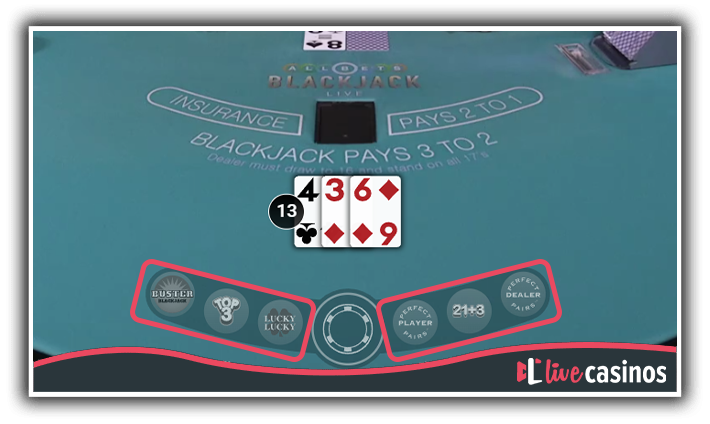Blackjack side bets are wagers available at many blackjack tables that allow players to bet on outcomes other than the main game of blackjack. For example, the Pairs side bet allows the player to predict that the first two cards they draw will be of the same rank.
Different blackjack side bets can be widely different in terms of how they work, what they predict, and how much they pay. In fact, the specific rules and payouts for some side bets can vary from table to table, even though the wager is called the same.
However, several of them have emerged as very popular, such as Perfect Pairs and 21+3. These common bets typically (but not always) have standardized rules and payouts that are the same between different games and casinos. In fact, Blackjack Insurance can be considered a side bet, though it’s so widespread these days that you would be hard-pressed to find a table that doesn’t offer it.
In other cases, blackjack side bets can be completely unique to a specific table or online blackjack game. This helps certain games stand out from the crowd by offering features and bets that you wouldn’t be able to find anywhere else.
Importantly, the result of a side bet in blackjack is not necessarily the same as the main bet. For example, you could lose the main blackjack hand but win a side bet, or vice versa.
How Blackjack Side Bets Work
To place a side bet in blackjack, all you have to do is put some chips down on the bet’s designated position. These can typically be found alongside the main betting area (the circle where you put chips for the main wager.)
In live casino blackjack games, side bets are used the same way as the main wager. Use the interface to select the size of your stake, then click on the bet you wish to make.
Online blackjack games may handle things differently based on what the UI looks like. However, they’re designed to be simple and intuitive, so it’s not hard to figure out how to place specific bets.
You can typically only place side bets during the betting period before the dealer starts handing out cards for the round. However, some exceptions to this exist, such as Insurance, which is placed after the dealer reveals their upcard.

Beyond that, we recommend that you carefully check the rules and payouts of any bet before attempting to place it. Although many common side bets have established standards, small variations still happen. For instance, some tables may not pay as much as others for the same outcome.
Common Blackjack Side Bets Explained
We’ll now go through many types of common side bets we’ve encountered in live casino blackjack games.
To clarify, by “common”, we mean that this type of bet can be found on many different tables with largely consistent rules and payouts. We should still stress that there are side bets out there that only appear in specific casinos or games, and are not covered by this guide. However, the guide should still give you a solid understanding of how most blackjack side bets work and whether you should play them.
Importantly, note that different games and casinos may offer different odds for some of these bets. Details such as reduced payouts can severely alter the RTP and statistics of these wagers, so make sure that the table’s rules match what we presented here.
The probabilities and RTP rates provided here assume you’re playing with a fresh shoe that contains either 6 or 8 decks. That accounts for the vast majority of live casino blackjack games, but you should still note that the odds are quite different if the shoe contains fewer decks.
Also, the odds and probabilities are affected by which cards are still in the shoe, so they tend to vary slightly based on previous rounds and current deck penetration. In other words, the card count affects side bets in blackjack, but is typically not seen as a viable way to gain an advantage with them.
Perfect Pairs
The Perfect Pairs side bet in blackjack wins if the player’s first two cards are of the same rank. For example, if your initial two cards are two 7s, the bet wins.
This bet pays additional rewards if the two cards also have the same color or suit. As such, there are three distinct ways to win Perfect Pairs:
- Pair – Two cards of the same rank, but different colors and suits. For example, a 7 of Clubs and a 7 of Hearts. This outcome typically pays 6:1.
- Colored Pair – Two cards of the same rank and color, but different suits. For example. A 7 of Clubs and a 7 of Spades is a Colored Pair. This outcome typically pays 12:1.
- Perfect Pair – Two cards of the same rank and suit. For example, two 7s of Clubs would be a Perfect Pair. This is the best possible outcome, typically paying 25:1.
Perfect Pairs is one of the most common blackjack side bets in the world, and it can be found on almost every modern online blackjack game. The bet’s simplicity is one of its biggest strengths: it has clear and ubiquitous rules, and it resolves as soon as the round begins. Additionally, players are often attracted to the potential payout of 25:1.
However, Perfect Pairs also suffers from a comparatively high house edge. The version we described above has a house edge of around 4.09%, which makes it much weaker than the main bet and its 0.50% HE. Broadly speaking, it’s quite risky with barely 6% chances of winning.
There are also several variants of Perfect Pairs out there with different rules and paytables. You can check out a more in-depth analysis and exploration of these variants in our guide to Perfect Pairs in blackjack.
The variant shown in the table is by far the most common. It can be found in many live blackjack games, such as Live Blackjack by Evolution.
Perfect Pair
The Perfect Pair side bet, not to be confused with Perfect Pairs, is a comparatively rare side bet that only wins if the player draws two cards of the same rank and suit. Additionally, the bet pays much more if the dealer’s first two cards are also of the same rank and suit.
Unlike the plural Perfect Pairs, this bet essentially only pays for Perfect Pairs. Regular and colored pairs lose the bet.
However, this version also adds the chance to hit two Perfect Pairs, which skyrockets the payout to 250:1. Of course, this is an extremely unlikely outcome.
As such, it’s a much riskier and more volatile wager than the (already volatile) Perfect Pairs. It’s also quite rare and has an even steeper house edge.
We don’t recommend giving this bet a try due to its extremely low probability and low RTP.
Any Pair (Pair Square)
The Any Pair side bet in blackjack wins if the player’s first two cards are of the same rank, typically also paying more if the cards are of the same suit.
This bet is very similar to Perfect Pairs in many ways. However, its paytable is a bit different, which makes it less volatile.
Specifically, regular Pairs pay more than in Perfect Pairs, but no increased payouts are offered for colored Pairs. Suited Pairs pay the same in both types of bets.
While Perfect Pairs are more common these days, Any Pair is on par with Perfect Pairs in most regards. Their RTP rates are nearly identical, and the probability of winning the bet is largely the same as well. As such, picking between the two is largely a matter of personal preference.
21+3
The 21+3 side bet in blackjack attempts to make simple 3-card poker hands by combining the player’s first two cards and the dealer’s upcard. It pays depending on the strength of the poker hand, typically ranging from Flush to Suited Three of a Kind.
The most common version of the game has a scaling paytable whose prizes depend on the strength of the poker hand. Here they are, ranked from weakest to strongest:
- Flush: Three cards of the same suit, not in consecutive order. For example, a 2, a 7, and a King of Spades.
- Straight: Three cards of different suits whose ranks are in consecutive order. For example, a 5 of Clubs, 6 of Hearts, and 7 of Spades.
- Three of Kind: Three cards of the same rank but different suits. For example, a King of Hearts, a King of Clubs, and a King of Diamonds.
- Straight Flush: Three cards of the same suit whose ranks are in consecutive order. For example, a 5, 6, and 7 of Spades.
- Suited Three of a Kind: Three cards of the same rank and suit. For example, three Kings of Spades.
If your hole cards and the dealer’s upcard don’t combine into any of the above hands, the 21+3 bet loses. For more information on poker hands and how they’re assembled, check out this article.
This side bet can be exciting to play, but it has a much steeper house edge than the main bet – 3.70% compared to 0.50%. It also allows players to win up to 100:1, which is important considering high payouts are one of the main reasons people enjoy side bets in the first place.
The paytable below covers every possible winning outcome of the 21+3 blackjack side bet alongside the most common payouts associated with those outcomes.
TriLux
The TriLux side bet in blackjack wins if the player’s first two cards and the dealer’s upcard form a three-card poker hand that’s at least a Flush or stronger.
This bet is very similar to 21+3 in most ways. However, it does not offer a scaling paytable based on hand strength, instead paying 8:1 for every possible winning outcome.
Compared to 21+3, TriLux is much less common and boasts lower payout potential. Even worse, it has a very high house advantage, which is why most players tend to steer towards 21+3. TriLux is also much less volatile and more consistent, which can be valuable for certain strategies.
Top 3
The Top 3 side bet in blackjack is a variation of the more common 21+3 that only pays if the player’s first two cards and the dealer’s up-card form a Three of a Kind, a Straight Flush, or a Suited Three of a Kind.
Essentially, it’s a 21+3 bet that pays huge rewards but only for extremely unlikely outcomes. The payouts are higher than in the basic 21+3, but you can’t win with hands such as a Flush or Straight. All of this makes the bet even more volatile, limiting its usefulness.
Worse still, the Top 3 side bet has a particularly high house edge of 9%, which basically makes it a worse version of 21+3.
Player Blackjack
The Player Blackjack side bet in blackjack allows the player to predict that they will win a natural 21 (blackjack) before the round begins. It’s one of the simplest and oldest side bets in blackjack, paying 17:1 in most examples.
The goal of this wager is simply to squeeze extra winnings from a blackjack. The wager is very countable due to how most card counting systems like the Hi-Lo work, so it can be an interesting option for highly ambitious players.
However, the Player Blackjack side wager also typically has a very high house edge, which makes any attempts at counting pointless. The casino advantage is simply too big to overcome, no matter the count.
Of course, that’s assuming the bet pays 17:1. If you can find a version with payouts of 19:1, Player Blackjack becomes worthwhile. Otherwise, we recommend avoiding it.
Blackjack Bonus
A number of side bets have been called ‘blackjack bonus’ over the years in various casinos and games. This name is often simply used for unique additional options provided by specific casinos and tables. However, this variant has popped up enough times to be worth mentioning.
The Blackjack Bonus bet wins if the player wins with a blackjack, draws a Pair (two cards of the same rank), or if their first two cards are of the same suit. If the dealer also hits Blackjack or if the player hits Blackjack using two cards of the same suit, the payouts are substantially increased.
This wager is an interesting combination of the Pairs and Player Blackjack side bets, offering a moderately poor house edge. However, many players find it a fun way to boost their returns with lucky hands. Moreover, the ability to win with any two suited cards makes it an easy bet to win despite the lackluster rewards.
Royal Match
The Royal Match side bet in blackjack wins if the first two cards the player draws are of the same suit, paying 2.5:1. The bet also pays a bonus if the first two cards are a King and a Queen of the same suit, which pays 25:1.
This is a simple side wager that you won’t find on many tables. For better or worse, the odds and rules of the bet are fairly inconsistent across different tables. If you run across a Royal Match option, make sure you carefully check the rules and payouts and compare them to the ones provided here.
It’s marked by a relatively high probability of success (almost 25%), though the house edge is still quite steep at 6.66%.
The Royal Match bet can be useful because it’s countable – just pay attention to the suits of cards as they’re removed from the shoe. If you notice that a particular suit (or two) hasn’t appeared many times, it may be a good time to place a Royal Match bet.
That said, it’s highly unlikely that you’ll ever actually overcome the house edge by counting because it’s so high. Just note that the RTP of this bet can be higher depending on the state of the shoe.
Buster (Bust It)
The Buster side bet in blackjack wins if the dealer busts by going over 21. The more cards the dealer draws before going bust, the more the bet pays, up to a maximum of 250:1 for 8+ cards.
This type of side bet has been called different names by different providers and casinos, namely Bust It, Bust Blackjack, or simply Bust. However, the main premise of the wager remains the same: scaling payouts if the dealer goes over 21.
Although Buster bets in blackjack have been growing in popularity, they tend to suffer from a high house edge. However, the dealer has a 30.20% chance of going bust in any hand (assuming a fresh shoe), so the wager is relatively low-risk.
The main issue with Buster bets is that they tend to perform better if the shoe has a large number of low-ranking cards remaining. This contrasts with the fact that shoes stacked with high cards are broadly better for the player and their odds of winning the main hand.
As such, this wager can be useful for getting some value out of bad shoes, but the house edge is too steep for it to be useful in most cases.
Lucky Ladies
The Lucky Ladies blackjack side bet wins if the player draws a hand total of exactly 20. While any 20-point hand wins something, hands involving cards of the same suit or rank offer higher rewards. Additionally, specific card combinations that involve Queens offer higher payouts.
This side bet’s popularity means that it’s offered in many different variants, which often involves different prizes and different win conditions. The only consistent factor is that winning hands have to total 20 or involve Queens in some way.
The tables below show two common variants we’ve come across in multiple online casinos.
Variant 1
The first variant of Lucky Ladies is more concerned with 20s than Queens, only offering high rewards for pairs of Queens of Hearts. In practice, winning anything higher than a Matched 20 (a hand containing cards with the same suit and rank totalling 20) is extremely unlikely, which is why this variant has a dizzyingly high house edge of 17.64%.
Variant 2
The second version, which is more common in live casino blackjack tables, wins if the player draws any Queen. Better payouts are offered for a Queen of Hearts, and a special bonus is offered for a Pair of Queens of Hearts.
Beyond that, this version also pays different rates for hands totalling 20.
Overall, we can safely say that this is the superior version. It’s much more likely to win overall and consequently boasts a much lower house edge. Of course, the house edge is still high compared to the main bet, but it’s much more manageable than with Variant 1.
Lucky Aces
The Lucky Aces side bet in Blackjack wins if the player draws Aces during the regular round. The more Aces they draw, the better the payout, up to a maximum of 500:1 for four Aces. Additionally, bonus payouts are offered if the Aces are of the same suit, or if a single Ace of Diamonds is drawn.
This is a relatively rare side bet that boasts a similar premise to wagers such as Lucky 7s. While it’s relatively low-risk, Lucky Aces has an enormous house edge of around 15%, which makes it a poor option in almost any circumstance.
The main issue with the wager is that it encourages players to Hit contrary to basic strategy charts in the hopes of finding more Aces. Think about it – when was the last time you actually drew three Aces? Probably never, because you’ll typically Stand before even getting a chance to.
Maintaining basic strategy is more important than chasing highly volatile side bets like Lucky Aces, which is why we don’t recommend playing this wager.
Lucky Sevens
Lucky Sevens, also known as Super Sevens, Hot 7, or 777, is a side bet that wins if the first card the player draws is a 7. The payout progressively increases if the player’s second and third cards are also sevens. Additionally, if the sevens are of the same suit, the bet pays even more.
Note that if the dealer gets a blackjack, the player doesn’t get a chance to draw the third card and thus can’t win with three 7s. However, this rule may vary from table to table.
This bet is available in many different variants, with payouts sometimes going up to 5,000:1 for three suited 7s. However, the only live dealer blackjack table that’s confirmed to offer this wager is Live Blackjack by BetConstruct, which offers a particularly poor version with a massive house edge of almost 50%.
Since that’s the only version available in live dealer format, we’ll use it for the table. However, players should note that brick-and-mortar casinos can offer much more generous odds. That said, we’ve never seen a version of this wager with less than 10% house edge, so it’s a bad bet no matter how you look at it. The bet’s payouts are simply too low to match its highly unlikely win conditions.
Lucky 7’s is also sometimes called Blazing 7’s, in which case it often features a progressive jackpot element.
Lucky Lucky
Lucky Lucky is a side bet in blackjack that wins if the player’s first two cards and the dealer’s upcard form specific combinations. Different payouts are awarded for different outcomes, which include totals of 19, 20, and 21, as well as specific combinations such as 6-7-8 or 7-7-7.
Like with many other blackjack side bets, Lucky Lucky’s payouts may vary from table to table. However, the most common version is the one displayed on the table below, offering a house edge of around 3.95%.
With these odds, the Lucky Lucky side bet compares faovrably with many others on this list. Although its house edge is still much higher than the main game of blackjack, it’s a lot more manageable than the majority of other side bets. As such, it’s an acceptable way to add some variety to your game, but it’s still not an optimal decision in any circumstance.
Hot 3 (Lucky Lucky variant)
Hot 3 is a variation of the Lucky Lucky side bet in blackjack that wins if the player’s first two cards and the dealer’s up-card form specific combinations. Compared to Lucky Lucky, Hot 3 offers a different paytable and doesn’t pay on 6-7-8 combinations.
While simple and relatively easy to win, Hot 3 has a considerably higher house edge than most versions of Lucky Lucky. This makes it a strictly inferior variant that is best avoided.
The Hot 3 side bet can be found on Evolution’s Infinite Blackjack tables, among others.
Hi-Lo
The Hi-Lo side bet in blackjack wins if the player’s first card is higher than the dealer’s upcard. If the two cards are of the same rank, the bet loses. The only exception is if both cards are Aces, in which case the bet Pushes and the player’s stake is returned to them.
This is one of the simplest side bets in blackjack, but it never quite reached the same heights of popularity as Pairs and similar wagers.
It’s very straightforward, but the fact that most tie results result in a lost bet hurts the game’s RTP pretty badly. It has a house edge of around 6.90%, which is about average for side bets but fairly steep by almost any other standard.
Match the Dealer
The Match the Dealer side bet in blackjack wins if one or both of the player’s first two cards match the rank of the dealer’s upcard. The payouts are increased if both of the player’s first two cards match the same rank and/or if the cards are also of the same suit.
The Match the Dealer can work with any standard-rule blackjack table, but it’s not a very common sight among live dealer games. However, it’s one of the better blackjack side bets out there due to its reasonable house edge and relatively large payouts.
Fundamentally, this bet is relatively similar to Pairs bets, except that you’re trying to make a Pair using the dealer’s upcard. This also allows the wager to add additional win conditions, such as Three-of-a-Kind, which also makes it reminiscent of 21+3 or even Lucky Lucky.
Perfect 11
Perfect 11 is a simple blackjack side bet that wins of the player gets blackjack (natural 21) or a hand total of 11 with their first two cards. The payout is further increased if the cards are also of the same suit.
This is another short-but-sweet kind of side bet that’s not available on too many tables. It features a relatively steep house edge of 6.28% and moderately high payouts for very unlikely outcomes.
As such, it’s probably best avoided, but it’s also not the worst bet you can take as far as side wagers go.
Royal 20s
The Royal 20s blackjack side bet wins if the player’s first two cards have a hand total of 20. The payout is increased if the cards are also of the same suit, and a bonus is awarded if both cards are Queens, Jacks, or Kings (Royals.)
This side bet can be offered for both the Player and the Dealer. For example, a Dealer Royal 20s pays if the dealer’s first two cards add up to a total of 20. However, since the probability of a 2-card dealer 20 is the same as the probability of a 2-card player 20, these wagers are statistically the same.
Due to how card values in blackjack work, this bet can win with two possible combinations: two 10-value cards or a 9 and an Ace. Of course, Royals are more valuable than 10s for this wager, but this should still give you a clear idea of the bet’s goals.
Ultimately, Royal 20s suffers from an exceedingly high house edge, and is best avoided by most players.
Ten Twenty
The Ten Twenty side bet in blackjack wins if the player’s first two cards add up to a total of 10 or 20. Additionally, you can win an increased reward for an exact combination of 5-5.
All card values count as in standard blackjack, though Aces always count as 11. This doesn’t really matter since it’s impossible to get a total of 10 or 20 with just two Aces, but it’s still worth mentioning.
The Ten Twenty side bet has a house edge of 5.23% in an eight-deck game, which prevents it from being immediately useful. Also, it’s very similar to Lucky Lucky while offering worse odds. As such, players who want to make side bets targeting specific hand totals are better off sticking with Lucky Lucky.
Blackjack Side Bet Payouts and Odds
Blackjack side bets are extremely diverse in terms of their specific rules, possible outcomes, odds, and payouts. This means that some are more worth playing than others based on their house advantage, countability, and other factors.
However, if we look at the comparative odds of all blackjack side bets, a few trends become obvious:
- Side bets always have a higher house edge than the main bet in blackjack, which tends to sit between 1% and 0.5%.
- However, they still vary greatly between themselves, ranging from around 3% to almost 50%.
- On the other hand, side bets are the only way to win more than 1:1 or 3:2 while playing blackjack, which adds a lot to the excitement.
If you’re only interested in the odds of blackjack side bets, the table below lists all of the side bets we discussed in this guide, including their respective win probabilities and RTP rates. It allows you to quickly and easily compare the statistics of these wagers and decide which ones you wish to play.
House Edge Analysis
Unlike the main game, side bets in blackjack generally do not have an element of skill. You just make the bet and hope for the best, which means they’re completely based on luck.
As such, the house edge of every side bet is fixed and cannot be influenced by player decisions. However, several factors do affect the house edge of side bets in blackjack:
- The payouts – Some blackjack tables offer different payouts for the same outcomes of the same side bets, which directly impacts their house edge. Broadly speaking, the higher the payouts, the lower the house edge.
- Number of decks per shoe – As our tables point out, the house edge of blackjack side bets also depends on the number of decks in play. Having fewer decks is generally always better for the player because it increases the chances of winning the main hand. However, this isn’t always the case with side bets, which sometimes have better odds with more decks.
- The count – The figures provided above all assume you’re playing with a fresh shoe. However, the expected value of these bets can vary based on which cards have been played through and which ones are still in the shoe. If you make a side bet mid-shoe, the probability of winning it may be bigger or smaller based on which cards are still in play, which directly affects RTP.
With all of that in mind, the rule of thumb is this:
Side bets with a lower house edge (higher RTP) are always better than those with a higher edge. If you want to play side bets in blackjack, look for ones with the highest available RTP.
Having said that, we should point out that some bets are more affected by the card count than others. There are rare, specific circumstances in which a bet with a lower base RTP can have better expected value if the conditions are right, such as if the shoe contains cards that make the bet more likely to win. However, these situations are extremely rare and almost never that impactful.
As such, if you want to minimize the house edge of blackjack, the best thing to do is just to stick with the main bet. Play according to basic blackjack strategy and ignore the side bets altogether.
Of course, casino gaming is all about fun. If you want to enjoy side bets, feel free to do so. Just remember that side bets are always a sub-optimal decision from a statistical perspective.
Blackjack Side Bets Ranked by House Edge
The table below ranks common blackjack side bets based on their house edge, going from lowest to highest.
The rankings are based on HE figures for games that use 8 decks per shoe. In cases where these rankings conflict with 6-deck figures, the 8-deck edge takes precedence.
Are Side Bets Used in Basic Blackjack Strategy?
No, they’re not. Basic blackjack strategy only uses the main bet, relying on statistics to make the best possible decisions.
Basic blackjack strategy charts tell you the best possible move (Hit, Stand, Double, Split, or Surrender) in any given situation. Following these charts ensures you minimize the main game’s house edge down to around 0.50%.
As such, basic blackjack strategy never includes side bets. For starters, it only deals with the main game and its decisions.
Moreover, the high house advantage of these side bets ensures that making one is never the statistically optimal move.
From a purely statistical perspective, the best way to play blackjack is to avoid side bets entirely. However, we should remember that gambling is always a losing game – it’s just a matter of degrees. In other words, if you find them fun and want to take a crack at some big payouts, feel free to do so. We only recommend that you stick with options that have higher RTP rates.









































 Roulette
Roulette
 Blackjack
Blackjack
 Baccarat
Baccarat
 Poker
Poker
 Sic Bo
Sic Bo
 Dragon Tiger
Dragon Tiger
 Game Shows
Game Shows  Top 5 Games
Top 5 Games  See more
See more  Roulette Casinos
Roulette Casinos  Low Limit
Low Limit  High Limit / VIP
High Limit / VIP  Exclusive
Exclusive  How to Play
How to Play  Basic Strategy
Basic Strategy  Top Tips
Top Tips  FAQ
FAQ  Blackjack Casinos
Blackjack Casinos  Baccarat Casinos
Baccarat Casinos  Bonuses
Bonuses  Poker Casinos
Poker Casinos  Game Providers
Game Providers  Sic Bo Casinos
Sic Bo Casinos  Dragon Tiger Casinos
Dragon Tiger Casinos  Credit and Debit Card
Credit and Debit Card  e-Wallet
e-Wallet  Cryptocurrency
Cryptocurrency  Bank and Checks
Bank and Checks  Pay by Phone and SMS
Pay by Phone and SMS  See more
See more  How-To Guides
How-To Guides  Top Lists
Top Lists  In-Depth
In-Depth  Strategy
Strategy  Casino & Games
Casino & Games  Insight
Insight  News
News  Promotions
Promotions 
 Guide to Live Casinos
Guide to Live Casinos  Top 10 Live Casino Tips
Top 10 Live Casino Tips  Studio Locations
Studio Locations  FAQ & Help
FAQ & Help  Meet The Dealers
Meet The Dealers  Our Awards
Our Awards  How We Rate
How We Rate  Responsible Gambling
Responsible Gambling 




























 ENG
ENG 







 Facebook
Facebook
 Pinterest
Pinterest
 Twitter
Twitter
 LinkedIn
LinkedIn
 Copy Link
Copy Link 


















